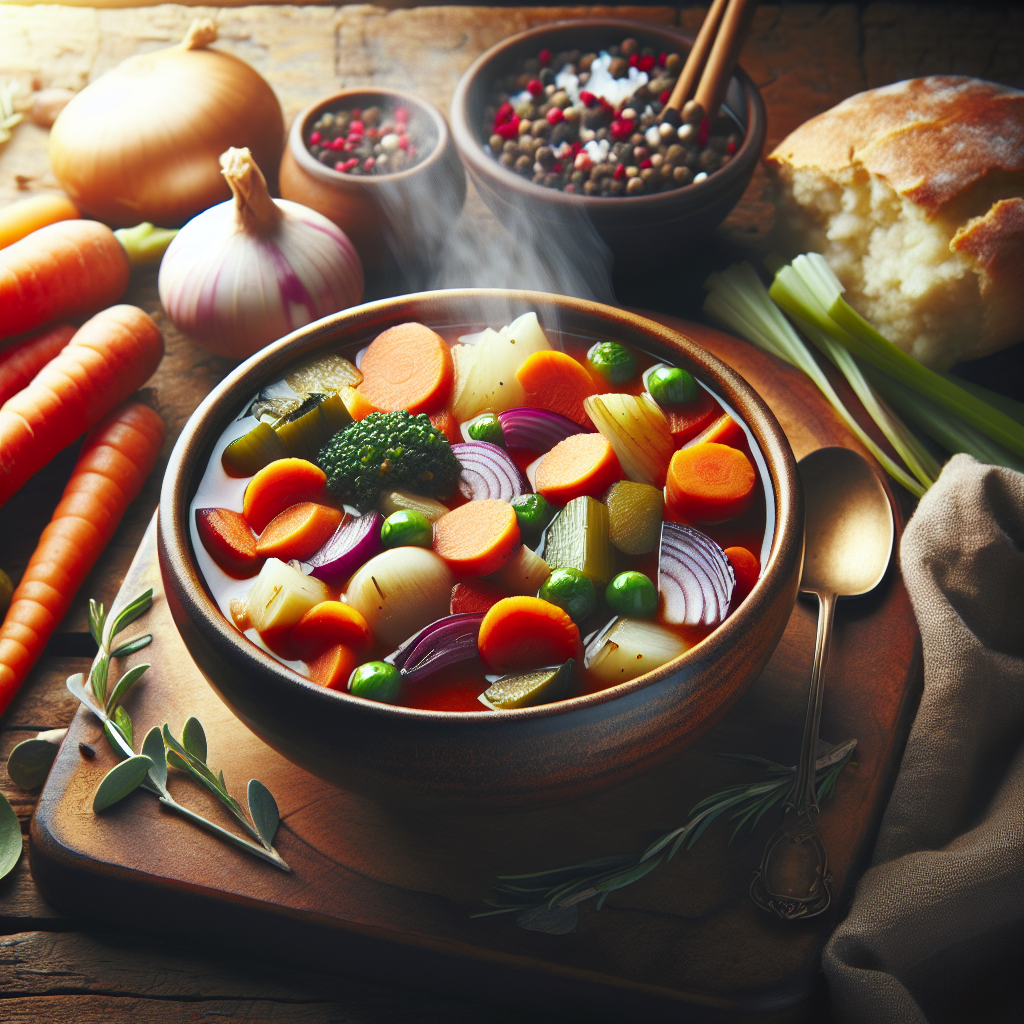Imagine a steaming bowl of goodness, packed full of vibrant vegetables and bursting with flavors. That’s exactly what you’ll find in the delightful creation known as Hearty Vegetable Stew. This dish is like a warm embrace on a chilly day, comforting and satisfying in every spoonful. With a medley of colorful veggies and a fragrant blend of herbs and spices, this stew is a hearty and wholesome option for those seeking a nourishing and delicious meal. Whether you’re a vegetarian or simply looking to add more plant-based dishes to your repertoire, this Hearty Vegetable Stew is sure to become a firm favorite in your kitchen.
Ingredients
Vegetables
The base of a hearty vegetable stew consists of a variety of vegetables. You can choose from common options like onions, carrots, celery, potatoes, and bell peppers. These vegetables provide the stew with flavor, texture, and plenty of nutrients.
Broth
To bring all the flavors together, you’ll need a good broth. Vegetable broth works great for a vegetarian option, while chicken or beef broth adds a savory depth for those who enjoy meat. You can use store-bought broth or make your own with leftover vegetable scraps, herbs, and water.
Herbs and Spices
Herbs and spices are essential for enhancing the taste of your vegetable stew. Popular choices include thyme, rosemary, bay leaves, black pepper, and salt. These seasonings add warmth and complexity to the stew, making every bite more enjoyable.
Other Ingredients
While the vegetables and broth are the main components, you may also want to consider adding other ingredients to customize your stew. This could include proteins like tofu or seitan for a vegetarian option, or meats like chicken, beef, or seafood for a heartier version. Additionally, grains or legumes such as lentils or barley can be added for extra texture and substance.
Preparation
Preparing the Vegetables
Start by washing and chopping your vegetables into bite-sized pieces. This allows them to cook evenly and ensures that each spoonful of stew contains a delicious mix of flavors. You can also peel the skins off potatoes or carrots if you prefer a smoother texture.
Making the Broth
If you’re using store-bought broth, simply heat it up in a large pot. However, making your own broth is an excellent way to add even more flavor to your vegetable stew. To do this, simmer vegetable scraps, herbs, and water together for an hour or two, strain the liquid, and you’ll have a homemade broth that enhances the taste of the stew.
Adding Herbs and Spices
Once your broth is ready, it’s time to add the herbs and spices. Sprinkle in a pinch of thyme, rosemary, bay leaves, black pepper, and salt to taste. However, be mindful not to overdo it – you can always add more seasoning later if needed.
Cooking the Stew
Now that all the key components are ready, bring the pot to a simmer and add the chopped vegetables. Let the stew cook over low heat for about 30-40 minutes or until the vegetables are tender but not mushy. Stir occasionally to ensure everything is cooked evenly.

Variations
Adding Protein
If you’re looking to make your vegetable stew more filling, consider adding protein. For a vegetarian option, you can incorporate tofu or seitan, both of which absorb the flavors of the stew and provide a satisfying texture. If you prefer a meaty stew, add cooked chicken, beef, or seafood to make it more substantial.
Customizing the Vegetables
While traditional vegetable stew recipes use common vegetables like onions, carrots, and potatoes, feel free to customize it to your liking. Add seasonal vegetables for a fresher taste or experiment with unique options like parsnips, turnips, or butternut squash for added depth and flavor.
Spicing it Up
If you enjoy a bit of heat, spice up your vegetable stew by adding chili flakes, cayenne pepper, or hot sauce. These additions not only add a kick but also enhance the flavors of the vegetables and spices.
Adding Grains or Legumes
To make your vegetable stew heartier and more filling, consider adding grains or legumes. Lentils, barley, or wild rice are excellent choices, as they release starches during cooking, naturally thickening the stew and providing extra protein and fiber.
Serving
Choosing Accompaniments
To complement your vegetable stew, consider serving it with fresh crusty bread or toasted garlic bread. The bread can be used to sop up the flavorful broth and add a delightful texture to each bite. Alternatively, you can pair it with a side salad for a lighter and refreshing contrast.
Garnishing Options
To add a touch of freshness and visual appeal, garnish your vegetable stew with some finely chopped herbs like parsley or cilantro. You can also sprinkle a bit of grated cheese or drizzle some olive oil over the top for added richness and flavor.
Storing and Reheating
If you have leftovers, allow the stew to cool completely before transferring it to an airtight container. It can be stored in the refrigerator for up to four days. When reheating, gently warm it on the stovetop over low heat or in the microwave, adding a little water or broth if needed to maintain the desired consistency.

Health Benefits
Nutrient-Rich Vegetables
A hearty vegetable stew is packed with nutrient-rich vegetables, providing you with a wide range of vitamins, minerals, and antioxidants. These ingredients contribute to your overall health and help support a strong immune system.
Immune System Boost
Vegetables such as onions and garlic, commonly used in a vegetable stew, contain natural compounds that can boost your immune system. By enjoying this stew, you’re giving your body an extra line of defense against common illnesses.
Heart Health
A vegetable stew made with wholesome and low-sodium ingredients can be beneficial for heart health. The vegetables and herbs used contribute to a balanced and nutritious meal that supports cardiovascular wellness.
Weight Management
A vegetable stew is an excellent option for those looking to manage their weight. It is low in calories while still providing a satisfying and filling meal. The high fiber content of the vegetables and added grains or legumes can help you feel full for longer, reducing cravings and overeating.
Tips and Tricks
Meal Prepping
Make your busy weeknights easier by meal prepping your vegetable stew. Prepare and chop the vegetables ahead of time, store them in airtight containers, and make the broth a day in advance. When you’re ready for a quick and nourishing meal, simply cook the stew, and you’ll have a delicious dinner in no time.
Flavor-Building Techniques
To enhance the flavors of your vegetable stew, consider sautéing the onions and garlic before adding the broth. This extra step brings out their natural sweetness and adds depth to the stew. Additionally, allowing the stew to simmer for a longer period of time can intensify the flavors and create a richer taste.
Using Leftovers
If you have leftover roasted vegetables, they can be a great addition to your vegetable stew. Simply chop them up and add them when you’re cooking the stew. The roasted vegetables will contribute a smoky and caramelized flavor, taking your stew to the next level.
Freezing for Later
If you have a surplus of vegetable stew or want to save some for future meals, freezing is a great option. Allow the stew to cool completely, transfer it to freezer-safe containers or bags, and label them with the date. The stew can be kept frozen for up to three months, providing an easy and comforting meal when you’re short on time.

FAQs
Can I Use Frozen Vegetables?
Absolutely! Using frozen vegetables is a convenient option, especially when certain types are out of season. They retain their nutritional value and can be added directly to the stew without the need for chopping. Just be sure to adjust the cooking time as frozen vegetables may cook faster than fresh ones.
How Long Does It Last in the Fridge?
When stored properly in an airtight container, vegetable stew can last in the refrigerator for up to four days. However, if you notice any changes in color, texture, or smell, it’s best to discard it to ensure food safety.
Can I Make It in a Slow Cooker?
Yes, making vegetable stew in a slow cooker is a great option for those who prefer a hands-off approach. Simply combine all the ingredients in the slow cooker, set it to the desired temperature, and let it cook for several hours until the vegetables are tender. This method allows the flavors to develop slowly, resulting in a rich and satisfying stew.
Budget-Friendly Option
Choosing Affordable Vegetables
To make your vegetable stew budget-friendly, opt for affordable vegetables that are in season. Root vegetables like potatoes, carrots, and onions are often reasonably priced and provide excellent flavor and texture.
Buying in Bulk
Consider purchasing your ingredients in bulk to save money in the long run. Store excess vegetables in a cool and dry place, ensuring they are properly stored to maintain their freshness for an extended period.
Using Homemade Broth
Instead of buying store-bought broth, save money by making your own homemade broth. It’s a simple process that utilizes vegetable scraps and herbs that would otherwise be discarded, turning them into a flavorful and cost-effective option for your stew.

Cultural Variations
Traditional European Stews
European stews often feature hearty ingredients like beef, pork, or lamb, combined with a medley of vegetables and fragrant herbs. They are known for their rich and comforting flavors, and each country has its own unique twist on the classic stew.
Asian-Inspired Twists
Asian-inspired vegetable stews often bring a unique combination of flavors with ingredients like ginger, soy sauce, and spices such as star anise or curry powder. These stews often incorporate vegetables like tofu, mushrooms, or bok choy, providing a delightful fusion of tastes.
South American Flavors
South American vegetable stews, such as Brazilian feijoada or Chilean cazuela, showcase an array of vibrant ingredients like corn, squash, and beans. These stews are spiced with traditional seasonings and herbs, resulting in a wholesome and comforting dish full of cultural flavors.
Conclusion
A hearty vegetable stew is a versatile and nutritious dish that can be tailored to your preferences and dietary needs. Whether you’re looking for a comforting meal on a cold day or a healthy option to nourish your body, this stew delivers on all fronts. So gather your favorite vegetables, spices, and herbs, and get ready to savor a bowl of warmth and goodness. Bon appétit!


